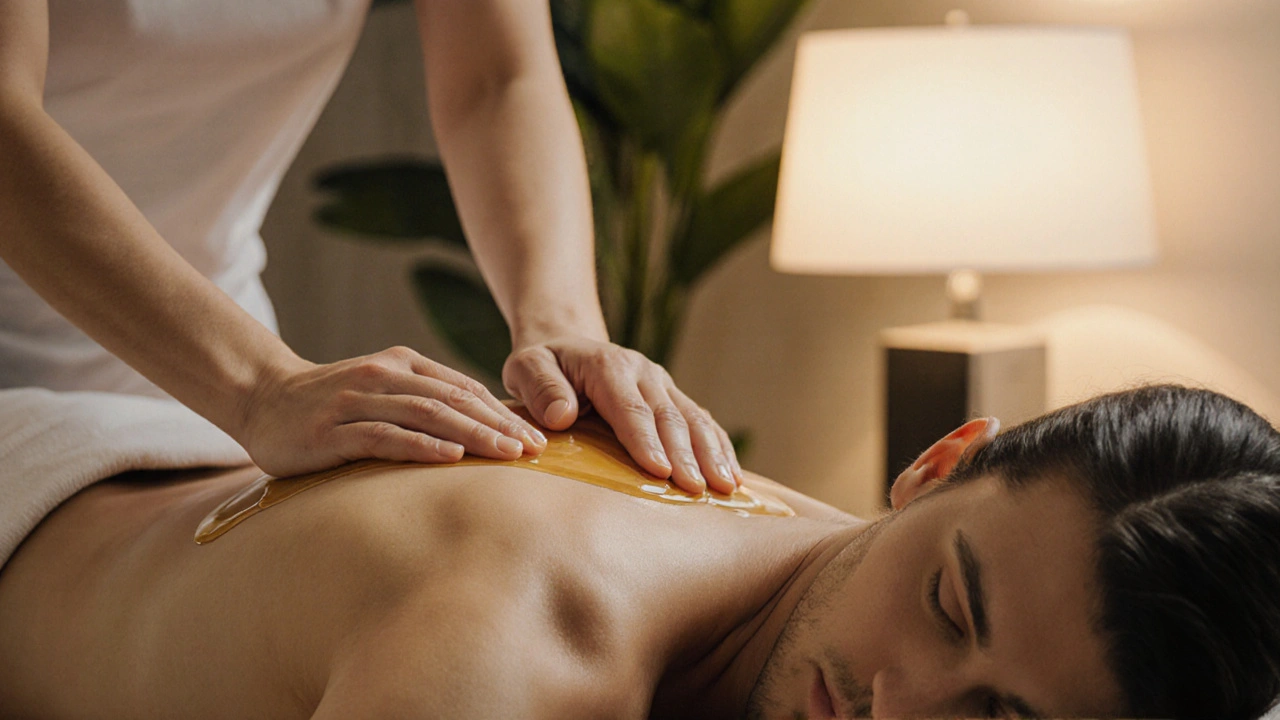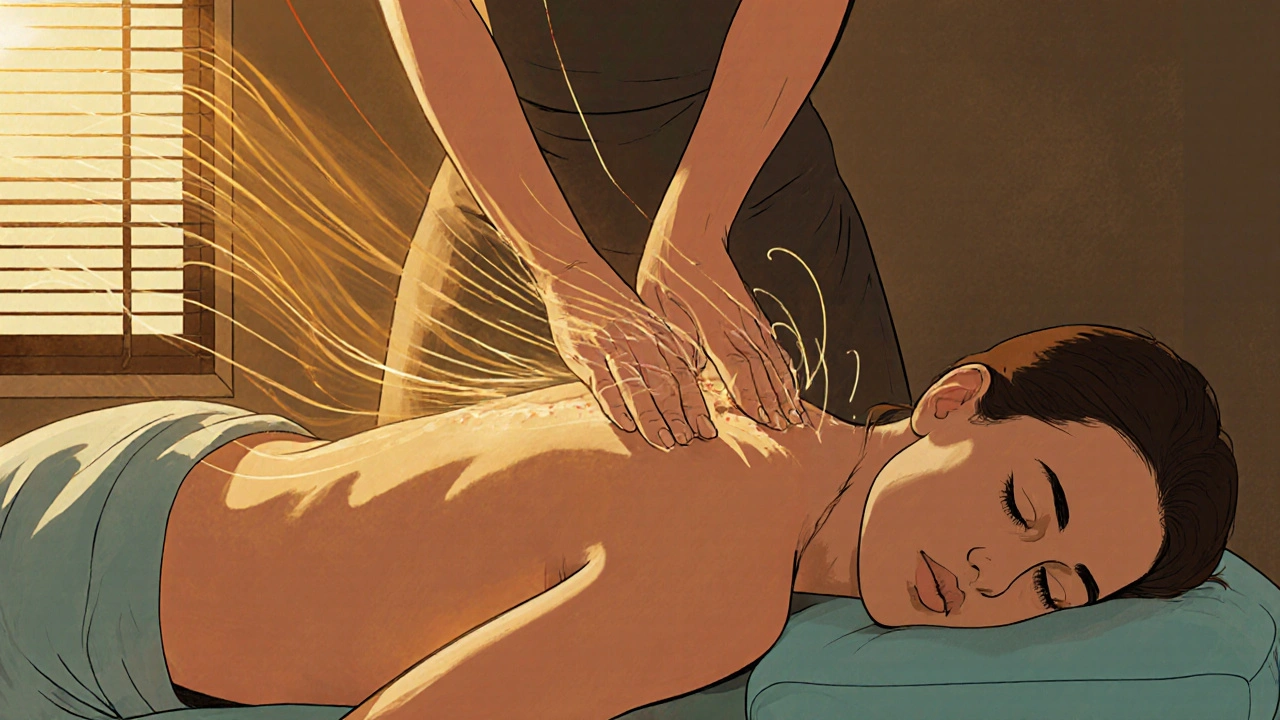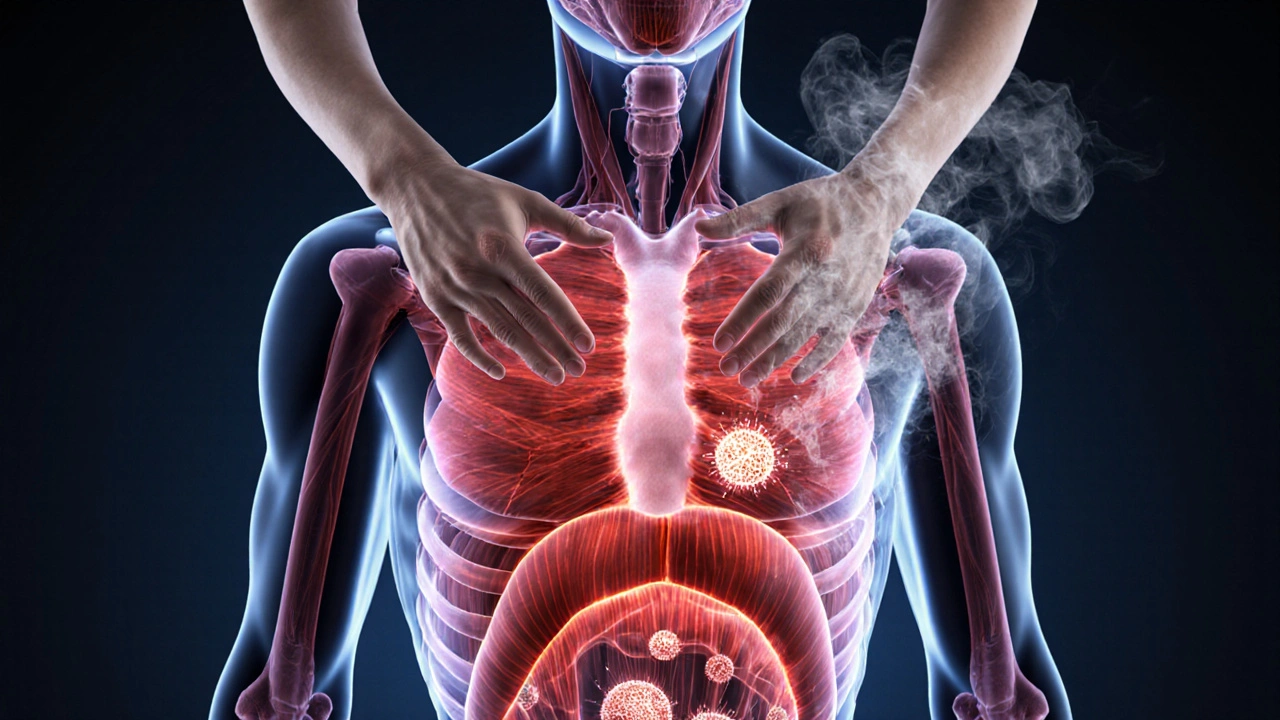Discover how massage therapist techniques like effleurage, tapotement, and myofascial release can naturally boost energy levels-without caffeine. Learn what works, who it's for, and how to find the right therapist in London.

- Created by: Liam Redgate
- Completed on: 3 Nov 2025
- Categories: Wellness
You’re dragging through the day. Coffee isn’t cutting it. Your eyes feel heavy, your shoulders are locked, and no matter how much you stretch, you just can’t shake that dull, heavy tiredness.
What if the answer isn’t more caffeine-or another nap-but a skilled massage therapist using targeted techniques to wake up your body from the inside out? This isn’t about relaxation alone. It’s about energy. Real, lasting, natural energy that doesn’t crash by 3 p.m.
Massage therapists don’t just melt tension. They rewire how your body handles fatigue. They use pressure, rhythm, and movement to trigger biological shifts that tell your nervous system: it’s time to wake up.
How Massage Actually Boosts Energy (It’s Not Magic)
Let’s cut through the fluff. Energy isn’t just about feeling awake. It’s about your mitochondria-the tiny power plants in your cells-producing ATP, your body’s fuel. When you’re exhausted, those mitochondria slow down. Stress hormones like cortisol flood your system, and your muscles stay tight, stealing oxygen and blood flow.
A skilled massage therapist interrupts that cycle. Here’s how:
- Increases circulation: Blood carries oxygen and glucose to tired muscles. Better flow = more fuel.
- Reduces cortisol: One study in the Journal of Clinical Psychology showed a single 45-minute massage lowered cortisol by 31% in participants with chronic fatigue.
- Stimulates the parasympathetic nervous system: This is your body’s ‘rest and digest’ mode-but paradoxically, it’s the key to resetting energy. When your body stops being in survival mode, it can actually rebuild.
- Releases endorphins and serotonin: These aren’t just ‘feel-good’ chemicals. They sharpen focus, lift mood, and reduce the perception of fatigue.
Think of it like rebooting a frozen laptop. You’re not adding more power-you’re clearing the backlog so the system can run smoothly again.
Techniques Massage Therapists Use to Spark Energy
Not all massages are created equal when it comes to energy. If you want to feel energized-not just sleepy-you need specific techniques. Here’s what top therapists in London use:
1. Effleurage with Rhythmic Pressure
This isn’t just gentle stroking. It’s long, flowing strokes applied with deliberate rhythm-usually 1-2 per second. The rhythm mimics the natural pulse of your body. When done correctly, it signals your nervous system to shift out of ‘freeze’ mode and into ‘alert’ mode.
Therapists often start here, using the palms and forearms to cover large areas like the back and legs. It’s not about depth-it’s about timing. The rhythm tells your brain: you’re safe, and now it’s time to wake up.
2. Petrissage for Muscle Activation
Imagine kneading dough-but your muscles are the dough. Petrissage involves lifting, rolling, and squeezing tissue. It’s deep enough to break up adhesions, but not so intense it triggers pain.
Why does this boost energy? Tight muscles restrict blood flow. When you release them, oxygen floods back in. Your cells start producing ATP again. Therapists focus on areas where fatigue hides: the trapezius (upper back), glutes, and calves.
3. Tapotement (Percussion)
This is the ‘wake-up call’ technique. Light, rapid tapping or cupping with the hands-think of it like a drummer hitting a snare. It’s used on the back, shoulders, and even the soles of the feet.
Tapotement doesn’t just stimulate muscles. It activates sensory nerves that send signals straight to your brainstem. Result? Instant alertness. Many athletes use this before training. It’s the massage equivalent of a cold splash of water on your face.
4. Myofascial Release for Restricted Movement
Fascia is the web of connective tissue that wraps around every muscle, nerve, and organ. When it gets sticky from stress or inactivity, it pulls your body out of alignment-and drains energy.
Therapists use sustained, gentle pressure (not force) to release these restrictions. You won’t feel a ‘pop’-just a slow unwinding. Afterward, people often say: ‘I didn’t realize how heavy I felt until I wasn’t anymore.’
5. Joint Mobilization (Not Cracking)
Stiff joints-especially in the spine and shoulders-limit movement. That forces other muscles to overwork. Over time, that’s exhausting.
Therapists use slow, controlled movements to gently glide joints through their natural range. No twisting. No cracking. Just smooth motion. It reduces joint stiffness, improves circulation, and gives your nervous system a sense of freedom. That freedom translates to energy.
What a Session Actually Feels Like
You walk in tired. Maybe you’ve been sitting at a desk since 7 a.m. Your neck feels like it’s made of concrete.
The therapist starts with light effleurage on your back. Warm oil glides over your skin. The room is quiet. Soft music plays. You close your eyes.
Then-change. The pressure shifts. Rhythmic strokes become deeper kneading. You feel your shoulder muscles soften. A few minutes later, there’s a quick, light tapping along your spine. You jerk slightly-not from pain, but surprise. Your body’s saying: Wait, I’m awake now?
By the end, you’re not sleepy. You’re… alert. Your breath is deeper. Your shoulders are lower. You feel like you’ve just had a good night’s sleep-but you’ve been lying on a table for 60 minutes.
That’s the magic. It’s not sedation. It’s recalibration.

Who Benefits Most?
This isn’t just for office workers. Anyone who feels stuck in low energy can benefit:
- Parents of young kids: Constantly running on fumes. A 45-minute session can restore mental clarity faster than another hour of sleep.
- Students: Cramming for exams? Fatigue clouds memory. Massage improves blood flow to the brain, helping focus and retention.
- Shift workers: Your circadian rhythm is scrambled. Massage helps reset your nervous system’s internal clock.
- People recovering from illness: Chronic fatigue after infection? Massage supports immune function and reduces inflammation.
The common thread? They’re all stuck in a cycle of exhaustion. Massage doesn’t fix the root cause-but it gives you the energy to deal with it.
How to Find the Right Therapist in London
Not every massage therapist knows how to boost energy. Some specialize in relaxation. Others in pain relief. You need someone who understands physiology-not just technique.
Here’s how to find them:
- Look for credentials: Check for qualifications from the Complementary and Natural Healthcare Council (CNHC) or the Federation of Holistic Therapists (FHT). These aren’t just certificates-they mean they’ve studied anatomy and physiology.
- Ask the right question: Don’t say, ‘Do you do energy massages?’ Say: ‘I’m looking for a session to help with chronic fatigue. What techniques do you use to help clients feel more alert?’
- Read reviews carefully: Look for phrases like: ‘left feeling energized,’ ‘not sleepy,’ ‘cleared my head.’ Avoid reviews that just say ‘very relaxing.’ That’s not your goal.
- Try a 45-minute session first: You don’t need a 90-minute treatment to feel the difference. Start short.
Therapists in Soho, Camden, and Notting Hill often specialize in energy-focused work. Many offer post-work sessions-perfect if you’re coming straight from the office.
Pricing and What to Expect
Energy-boosting sessions aren’t luxury spa experiences. They’re therapeutic. Prices reflect that.
In London, expect:
- 45 minutes: £55-£75
- 60 minutes: £75-£95
- 90 minutes: £100-£130
Higher prices usually mean more experience, better training, or a clinic with medical-grade equipment (like infrared heat pads or lymphatic drainage tools). Don’t go cheap if you’re serious about results.
Booking is simple: most therapists take appointments online. Look for platforms like Bookings.com or local clinic websites. Some offer package deals-3 sessions for the price of 2. That’s smart if you’re dealing with long-term fatigue.

What Not to Do After Your Session
You just got an energy boost. Don’t waste it.
- Don’t go straight back to your desk: Your nervous system is still adjusting. Take a 10-minute walk outside. Let the fresh air in.
- Don’t drink alcohol: It depresses your nervous system. You just reversed that. Don’t undo it.
- Don’t eat a heavy meal: Your digestion is still waking up. Go for light protein and greens.
- Do drink water: You flushed toxins. Rehydrate.
- Do sleep well that night: Your body will be repairing. Let it.
Massage vs. Other Energy Boosters
| Method | Energy Boost Duration | Side Effects | Long-Term Benefits |
|---|---|---|---|
| Coffee | 1-3 hours | Anxiety, crash, disrupted sleep | None |
| Energy Drinks | 2-4 hours | Heart palpitations, sugar crash | None |
| Exercise | 4-8 hours | Can be too taxing if you’re already fatigued | Yes-improves mitochondrial function |
| Massage Therapy | 8-24 hours | Minimal-rarely soreness | Yes-reduces cortisol, improves circulation, resets nervous system |
Massage doesn’t just give you a quick spike. It fixes the system that’s draining your energy in the first place.
Frequently Asked Questions
Can massage really help with chronic fatigue?
Yes. A 2022 study in the Journal of Bodywork and Movement Therapies found that participants with chronic fatigue syndrome who received weekly massage for 8 weeks reported a 40% increase in energy levels and improved sleep quality. It doesn’t cure the condition, but it helps your body cope better.
How often should I get a massage for energy?
Start with once every two weeks. If you notice a steady improvement, you can space it out to once a month. If you’re under high stress-think exams, new babies, or demanding jobs-once a week for 4 weeks then taper off works best.
Is deep tissue massage good for energy?
Not always. Deep tissue is great for pain, but if you’re already exhausted, too much pressure can trigger inflammation and make you feel worse. Look for therapists who use firm but rhythmic pressure-not brute force.
Can I do this at home?
You can try self-massage with a foam roller or tennis ball, but it won’t be as effective. A therapist applies pressure at the right depth, rhythm, and timing-things you can’t replicate alone. Think of it like trying to fix your own car vs. taking it to a mechanic.
Do I need to undress?
You’ll be covered with towels at all times. Most energy-boosting sessions focus on the back, shoulders, arms, and legs-you can keep your underwear on. Only your treatment area is exposed. Privacy and comfort come first.
Ready to Feel Alive Again?
You don’t have to live in a fog of fatigue. Your body was built to move, breathe, and recover. Sometimes, all it needs is someone who knows how to help it reset.
Book that session. Give yourself 60 minutes-not as a luxury, but as a necessary reset. You’ll walk out not just less tense, but lighter. Brighter. More alive.

Melissa Pemberton
November 4, 2025 AT 17:31omg yes!! i got a massage last week after pulling 3 all-nighters for work and i swear i felt like a new person?? not just relaxed but like my brain finally stopped buzzing?? i didnt even need coffee the next day lmao
Vicky Durel
November 6, 2025 AT 10:35interesting how they never mention the real reason this works… it’s not the massage, it’s the fact that you’re lying still for an hour while someone touches you. modern life is so overstimulated that silence and touch are the only things that reset us. also, did you know the government secretly funds massage schools to keep people docile? lol just saying.
Matt Ferry
November 7, 2025 AT 14:08Let’s be honest - the cortisol reduction study cited? Tiny sample size. The ‘parasympathetic reset’ claim? Vague neurobabble. And tapotement as a ‘wake-up call’? That’s just percussion therapy from the 90s repackaged as ‘energy boosting.’ Meanwhile, exercise actually builds mitochondrial density. Massage is nice, but don’t sell it as a cure-all.
Richard Reyes
November 8, 2025 AT 20:48Thank you for this thoughtful, science-backed piece. 🙏 I’ve been a massage therapist for 18 years, and I’m so glad to see someone articulate the physiology clearly. Many clients come in exhausted and leave with a quiet confidence - not because they were ‘relaxed,’ but because their nervous system was finally allowed to recalibrate. 🌿
Leanne McNally
November 10, 2025 AT 10:31so basically massage is just a fancy nap with better vibes? 🤔 i mean, i get it - my body feels like a rusty robot after 8 hours of Zoom. but let’s not pretend this isn’t just ‘touch therapy’ with a fancy name. also, who even has $75 to spend on a 45-minute lie-down? i’m out here drinking cold brew and screaming into a pillow.
Kristin Kuchenbecker
November 12, 2025 AT 04:48Wow. This. This is exactly what I needed to read today. I’ve been feeling this low-grade exhaustion for months - like my energy is leaking out through my keyboard. I tried everything: supplements, cold showers, intermittent fasting… but nothing clicked until I read this. I booked my first session yesterday. I’m not just hopeful - I’m actually excited. Thank you for writing this. 🌞💛